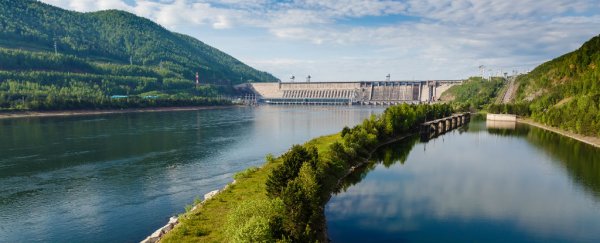Just yesterday, Earth crossed a major (and very scary) threshold, with scientists announcing that levels of atmospheric CO2 have officially surpassed 400 parts per million, and there's little hope of them ever returning them to safe levels.
And now, things are looking even worse, because a new study has identified a whole new source of greenhouse gas emissions that we hadn't even considered, and it's responsible for more atmospheric CO2 and methane than the entire nation of Canada.
Just to put that into perspective, we're talking about something that's been spewing roughly 1 gigaton (1 billion tons) of carbon dioxide a year, and 1.3 percent of all greenhouse gases produced by humans, into our atmosphere this whole time - and we had no idea.
So if you thought the situation was bad before, it just got a whole lot worse.
And wait till you hear what this newly discovered source of greenhouse gases is: the dams and reservoirs used to generate 'clean' hydroelectric power and irrigate crops in some 1 million facilities around the world.
What's particularly worrying is that a whopping 79 percent of the gas produced by these reservoirs is methane, which has up to 36 times the global warming potential of carbon dioxide - a measurement that takes into account a gas's ability to absorb energy, and how long it stays in the atmosphere.
Carbon dioxide and nitrous oxide were found to make up the remaining 17 percent and 4 percent of the reservoir emissions, respectively.
The discovery was made by an international team of scientists, who just completed the largest study of reservoir greenhouse gas emissions to date.
They analysed more than 200 previous studies on potential emissions from 267 dams and reservoirs around the world, which have a combined surface area of almost 30,000 square miles (77,699 square km).
When all the information was collated, they found that these facilities were considerably worse for the environment than anyone had expected.
"There's been kind of an explosion in research into efforts to estimate emissions from reservoirs. So we synthesised all known estimates from reservoirs globally, for hydropower and other functions, like flood control and irrigation," one of the team, Bridget Deemer, from Washington State University, told Chris Mooney at The Washington Post.
"And we found that the estimates of methane emissions per area of reservoir are about 25 percent higher than previously thought, which we think is significant given the global boom in dam construction, which is currently underway," she added.
As Deemer points out, it's not just hydroelectric facilities that are contributing to these massive, unaccounted-for amounts of greenhouse gases - it's all artificial dams and reservoirs.
So basically, if we've deliberately flooded areas of land to generate energy, irrigate our crops, or perform flood control, we're contributing to the accelerated warming of the planet.
As the team explains, human-made reservoirs tend to flood vast areas that contain large amounts of organic life, such as grass and leaf matter, all in one go.
As this carbon-rich matter is smothered in water, it very rapidly runs out of oxygen, and this gives rise to populations of microorganisms that breathe CO2 and produce methane as a byproduct.
Many of these dams are also fed by freshwater rivers, which carry in them a whole lot of new organic matter, which means the cycle can continue long after the original stuff has rotted away.
Natural bodies of water, on the other hand, like lakes, ponds, rivers, or wetlands, have developed far more gradually, and are much less likely to run out of oxygen like dams and reservoirs.
"If oxygen is around, then methane gets converted back to CO2," one of the team, John Harrison from Washington State, told The Post. "If oxygen isn't present, it can get emitted back to the atmosphere as methane."
So does that mean hydroelectric power is no longer a viable option?
Not necessarily, the researchers say, but stress that we need to be far more informed about the potentially harmful side-effects of massive facilities like dams and reservoirs - which fundamentally change vast amounts of land very quickly - and take that into account when we're figuring out how far we need to go to 'decarbonise' the global economy.
"We're trying to provide policymakers and the public with a more complete picture of the consequences of damming a river," said Harrison.
The research has been accepted for publication in next week's edition of BioScience.
